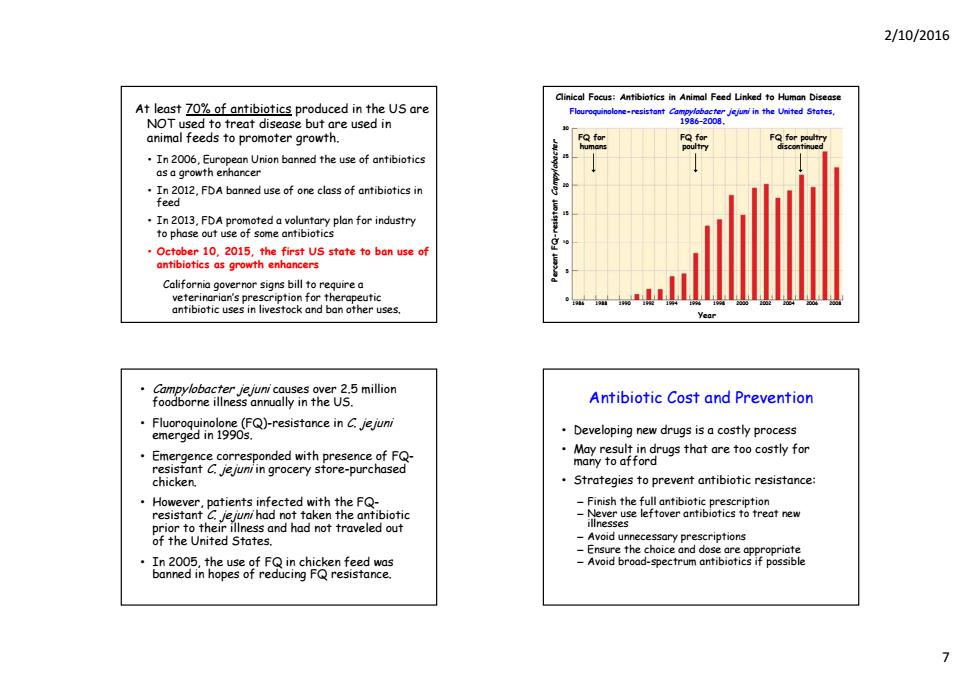正在加载图片...

2/10/2016 Clinical Focus:Antibiotics in Animal Feed Linked to Humen Disease At least 70%of antibiotics produced in the US are NOT used to treat disease but are used in animal feeds to promoter growth. FQ for In 2006,European Union banned the use of antibiotics as a growth enhancer In2012.FDA banned use of one class of antibiotics in feed In 2013.FDA promoted a voluntary plan for industry to phase out use of some antibiotics October 10.2015,the first US state to ban use of antibiotics as growth enhancers California governor signs bill to require a veterinarian's prescription for therapeutic antibiotic uses in livestock and ban other uses. f8oe3opgeiCes5amayefmeU25mion Antibiotic Cost and Prevention Fluoroquinolone(FQ)-resistance in C.jejuni emerged in 1990s. Developing new drugs is a costly process May result in drugs that are too costly for many to afford chicken. Strategies to prevent antibiotic resistance: However,patients infected with the FQ- -Finish the full antibiotic prescription resistant C.jejuni had not taken the antibiotic -Never use leftover antibiotics to treat new illnesses -Avoid unnecessary prescriptions -Ensure the choice and dose are appropriate In 2005,the use of FQ in chicken feed was -Avoid broad-spectrum antibiotics if possible banned in hopes of reducing FQ resistance. >2/10/2016 7 At least 70% of antibiotics produced in the US are NOT used to treat disease but are used in animal feeds to promoter growth. • In 2006, p Euro ean Union banned the use of antibiotics as a growth enhancer • In 2012, FDA banned use of one class of antibiotics in feed • In 2013, FDA promoted a voluntary plan for industry to phase out use of some antibiotics • October 10, 2015, the first US state to ban use of antibiotics as growth enhancers California governor signs bill to require a veterinarian’s prescription for therapeutic antibiotic uses in livestock and ban other uses. Clinical Focus: Antibiotics in Animal Feed Linked to Human Disease FQ for humans FQ for poultry FQ for poultry discontinued obacter 25 30 Flouroquinolone-resistant Campylobacter jejuni in the United States, 1986–2008. Q-resistant Campylob 101520 1986 1988 1990 1992 1994 1996 1998 2000 2002 2004 2006 2008 Year Percent FQ 0 5 0 • Campylobacter jejuni causes over 2.5 million foodborne illness annually in the US. • Fluoroquinolone (FQ)-resistance in C. jejuni emerged in 1990s. • Emergence corresponded with presence of FQresistant C. jejuni in grocery store-purchased chicken. • However, patients infected with the FQresistant C. jejuni had not taken the antibiotic prior to their illness and had not traveled out of the United States. • In 2005, the use of FQ in chicken feed was banned in hopes of reducing FQ resistance. Antibiotic Cost and Prevention • Developing new drugs is a costly process • May result in drugs that are too costly for many to afford • Strategies to prevent antibiotic resistance: – Finish the full antibiotic prescription – Never use leftover antibiotics to treat new illnesses – Avoid unnecessary prescriptions – Ensure the choice and dose are appropriate – Avoid broad-spectrum antibiotics if possible